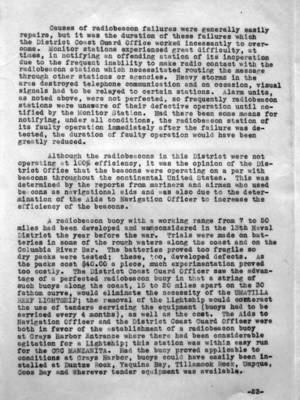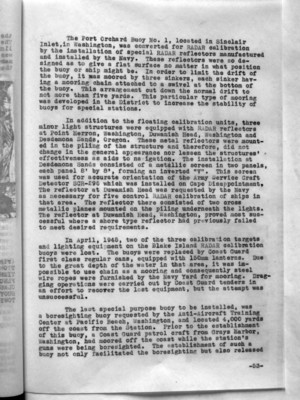Pages That Mention TENDERS
Coast Guard District narrative histories 1945
35
This plan met Headquarters' approval but was put into operation for only a brief time. Too many difficulties resulted to warrant the discontinuance of the relief. Water, sufficient only for 25 days, could be carried and this supply was greatly diminished when the fog signal was in operation. Special trips to replenish the water were made by the tenders, requiring a full day from their regular duties in the servicing of aids. The motor lifeboats were also required to deliver fresh food and vegetables and medical supplies. In addition to these difficulties, the proper operation of the radiobeacon was affected; batteries only charged full when the ship was off station because when charged over 1190 specific gravity while on station, the timer on the radiobeacon was thrown off. The 24-hour continuous beacon operation was a tremendous strain on the storage battery and generating equipment. The two-week schedule was not interrupted again until the RELIEF LIGHTSHIP #92 was placed on the Recognition Station, Strait of Juan de Fuca when the No. 88 needed relief for repairs. During one such relief, the Commanding Officer of the No. 92, a Chief Boatswain, performed the duties which were ordinarily handled by the seven officers aboard the Recognition Ship. Because of the efficient manner in which he handled this station, the Chief Boatswain was highly commended by the Navy.
Although the Light List indicated that radio messages of importance in the maintenance of aids to navigation, or on other urgent matters, could be received during the first fifteen minutes of each hour from 0800 to 2015, this service was not used for many years and, consequently, was discontinued in 1944 in order to replace the radioman who serviced the equipment by a radio technician to handle the radiobeacon equipment. The necessity of a technician became evident when a failure of the radiobeacon could not be remedied due to the lack of spare tubes aboard. A survey of the stock proved an adequate supply of tubes on hand, but the radioman was unfamiliar with the beacon equipment.
The war altered but slightly the routine of the LIGHTSHIP #92 and #93. Other than the issuance of small arms and a lookout for the northbound vessels, the lightships maintained and performed their peacetime duties. The regular radiobeacon equipment was operated alternately with the standby equipment to insure proper operation and repair on both units. It was discovered that the antenna on the main equipment was more efficient than that on the standby equipment so an antenna transfer switch was installed to permit operation of both transmitters on the main antenna. To preclude any failure of
42
Causes of radiobeacon failures were generally easily repairs, but it was the duration of these failures which the District Coast Guard Office worked incessantly to overcome. Monitor stations experienced great difficulty, at times, in notifying an offending station of its inoperation due to the frequent inability to make radio contact with the radiobeacon station which necessitated routing the message through other stations or agencies. Heavy storms in the area destroyed telephone communication and on occasion, visual signals had to be relayed to certain stations. Alarm units, as noted above, were not perfected, so frequently radiobeacon stations were unaware of their defective operation until notified by the Monitor Station. Had there been some means for notifying, under all conditions, the radiobeacon station of its faulty operation immediately after the failure was detected, the duration of faulty operation would have been greatly reduced.
Although the radiobeacons in this District were not operating at 100% efficiency, it was the opinion of the District Office that the beacons were operating on a par with beacons throughout the continental United States. This was determined by the reports from mariners and airmen who used beacons as navigational aids and was also due to the determination of the Aids to Navigation Officer to increase the efficiency of the beacons.
A radiobeacon buoy with a working range from 7 to 50 miles had been developed and was considered in the 13th Naval District the year before the war. Trials were made on batteries in some of the rough waters along the coast and on the Columbia River Bar. The batteries proved too fragile so dry packs were tested; these, too, developed defects. As the packs cost $40.00 a piece, much experimentation proved too costly. The District Coast Guard Officer saw the advantage of a perfected radiobeacon buoy in that a string of such buoys along the coast, 15 to 20 miles apart on the 30 fathom curve, would eliminate the necessity of the UMATILLA REEF LIGHTSHIP; the removal of the Lightship would counteract the use of tenders servicing the equipment (buoys had to be serviced every 4 months), as well as the cost. The Aids to Navigation Officer and the District Coast Guard Officer were both in favor of the establishment of a radiobeacon buoy at Grays Harbor Entrance where there had been considerable agitation for a Lightship; this station was within easy run for the CGC MANZANITA. Had the buoy proved applicable to conditions at Grays Harbor, buoys could have easily been installed at Duntze Rock, Yaquina Bay, Tillamook Rock, Umpqua, Coos Bay and Wherever tender equipment was available.
-23-
61
be blacked out by the unit having charge of that area. Commanding Officers were instructed to exercise their best judgement in the assignment of trucks, tenders, or small boats and these assignments were determined in advance.
Commanding Officers were further directed to familiarize themselves with the aids in their area, securing keys necessary for entrance to equipment and to properly instruct personnel under their command, in order that the blackout could be carried out smoothly and expeditiously. Sound buoys were silenced by securely lashing bell clappers or air intakes and whistles were wrapped with canvas and securely lashed. The District Coast Guard Office was to be notified by dispatch when the blackout had been effected or aids had been relighted, in accordance with District orders.
In October, 1941, a conference was held at Tongue Point Depot, Astoria, Oregon, to instruct personnel from that area in the operations required of the various types of aids to navigation to effect the Blackout Plan. A blackout drill of all units under command of the Astoria Base was held on October 22, 1941. Each aid was visited and examined by the personnel assigned thereto to ascertain type of equipment, the correct way to make the aid inoperative and the tools and materials required. During the practice, only an examination was made and the operation of the aids was not stopped. This was the only test of its kind in the 13th Naval District prior to the outbreak of the war.
On 9 December, 1941, a blackout was effected in the entire District on instructions from the District Commandant. Three officers, together with a small staff of enlisted personnel, issued instructions to the various Commands from the Aids to Navigation Office. Orders for the blackout were received at 1400 and, by 2200, the blackout was completely effected. Tremendous obstacles were encountered, there having been no previous test of the Plan as set by the Board in September. Bridges throughout the District were blacked out, although no plan had incorporated such procedure and railroad officials as well as highway superintendents offered little cooperation. No word was received from the blacked areas as to the time their aids were extinguished nor was word received that they had been relighted following the blackout. This was due to the inability of telephone and radio facilities to handle such heavy traffic. No report was required concerning the results of the operation and a general blackout, other than tests in various areas, was every made in the District.
-41-
73
The Port Orchard Buoy No. 1, located in Sinclair Inlet, in Washington, was converted for RADAR calibration by the installation of special RADAR reflectors manufactured and installed by the Navy. These reflectors were so designed as to give a flat surface no matter in what position the buoy or ship might be. In order to limit the drift of the buoy, it was moored by three sinkers, each sinker having a mooring chain attached to a swivel at the bottom of the buoy. This arrangement cut down the normal drift to not more than five yards. This particular type of mooring was developed in the District to increase the stability of buoys for special stations.
In addition to the floating calibration units, three minor light structures were equipped with RADAR reflectors at Point Herron, Washington, Duwamish Head, Washington and Desdemona Sands, Oregon. These metal reflectors were mounted in the piling of the structure and therefore, did not change in the general appearance nor lessen the structures' effectiveness as aids to navigation. The installation at Desdemona Sands consisted of a metallic screen in two panels, each panel 8' by 8', forming an inverted "V". This screen was used for accurate orientation of the Army Service Craft Detector SCR-296 which was installed on Cape Disappointment. The reflector at Duwamish Head was requested by the Navy as necessary for five control RADAR calibration of ships in that area. The reflector there consisted of two cross metallic planes mounted on the piling underneath the lights. The reflector at Duwamish Head, Washington, proved most successful where a shore type reflector had previously failed to meet desired requirements.
In April, 1945, two of the three calibration targets and lighting equipment on the Blake Island RADAR calibration buoys were lost. The buoys were replaced by Coast Guard first class regular cans, equipped with 150mm lanterns. Due to the great depth of the water in that area, it was impossible to use chain as a mooring and consequently steel wire ropes were furnished by the Navy Yard for mooring. Dragging operations were carried out by Coast Guard tenders in an effort to recover the lost equipment, but the attempt was unsuccessful.
The last special purpose buoy to be installed, was a boresighting buoy requested by the Anti-Aircraft Training Center at Pacific Beach, Washington, and located 4,000 yards off the coast from the Station. Prior to the establishment of this buoy, a Coast Guard patrol craft from Grays Harbor, Washington, Had moored off the coast while the station's guns were being boresighted. The establishment of such a buoy not only facilitated the boresighting but also released
-53-
97
At the outbreak of the war, the MANZANITA was fitted out and supplied with special submarine cables for the laying of a protective loop across the approach to Dutch Harbor and again, she was loaned to the Canadian authorities for the laying of a similar cable at Prince Rupert. The tenders performed their regular duties during the war, but were equipped with small arms, depth charge racks and deck guns for protection against enemy submarines. This armament was removed following cessation of hostilities and the complements of the tenders thereby gradually reduced.




